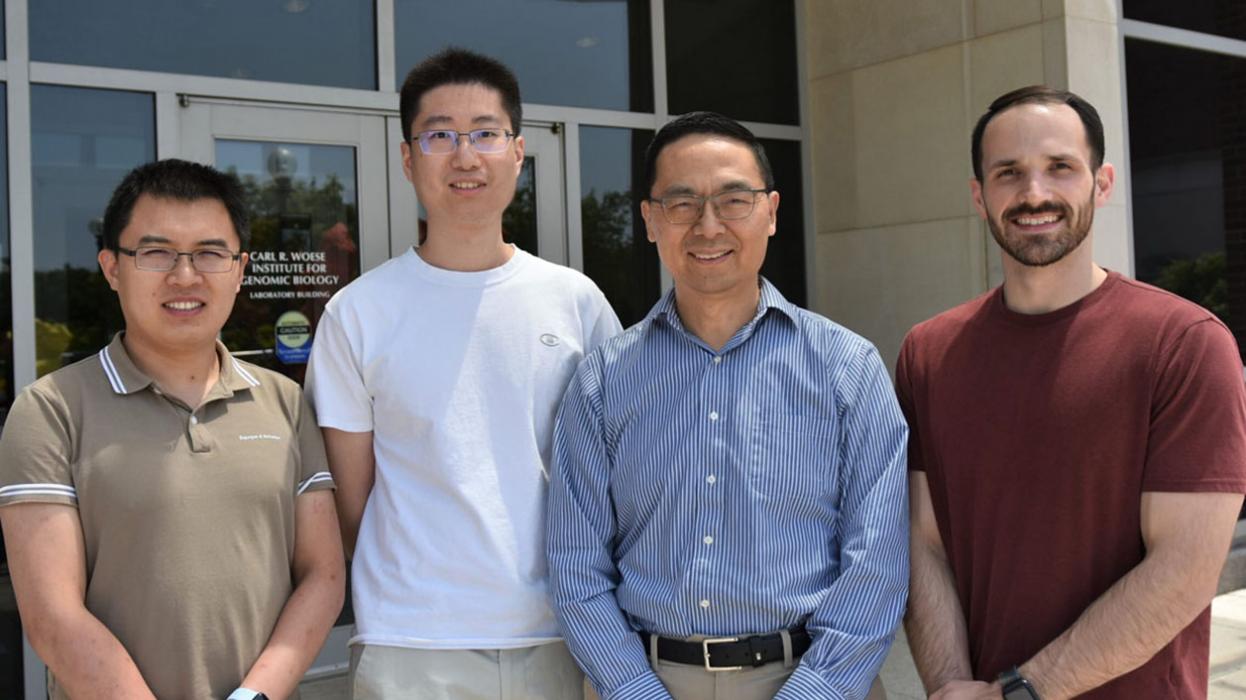CABBI develops eco-friendly enzyme to create key chemical building blocks

Co-authors on a recent study included, from left, Postdoc Haiyang Cui, CABBI Postdoc Zhenghi Zhang, CABBI Conversion Theme Leader Huimin Zhao, and CABBI graduate student Wesley Harrison, all from the Department of Chemical and Biomolecular Engineering at the University of Illinois Urbana-Champaign. / Julie Wurth
Using energy from light to activate natural enzymes can help scientists create new-to-nature enzymatic reactions that support eco-friendly biomanufacturing — the production of fuels, plastics, and valuable chemicals from plants or other biological systems.
Applying this photoenzymatic approach, researchers have developed a clean, efficient way to synthesize crucial chemical building blocks known as chiral amines, solving a longstanding challenge in synthetic chemistry.
The study, published in Nature Catalysis, included researchers from the Center for Advanced Bioenergy and Bioproducts Innovation (CABBI), a U.S. Department of Energy-funded Bioenergy Research Center; the Department of Chemical and Biomolecular Engineering (ChBE) at the University of Illinois Urbana-Champaign; and Xiamen University in China. It was led by CABBI’s Zhengyi Zhang, Postdoctoral Research Associate with ChBE Professor Huimin Zhao (BSD leader/CABBI/CGD/MMG), CABBI’s Conversion Theme Leader; and Jianqiang Feng and Binju Wang of the College of Chemistry and Chemical Engineering, Xiamen University.
Their work focused on hydroamination, a complex chemical reaction that can be used to produce chiral amines, which have wide applications in the synthesis of agrochemicals and other products. The team developed a photoenzymatic system that can control unstable nitrogen-centered radicals in a reaction known as enantioselective intermolecular radical hydroamination, which until now had been a major challenge in chemistry. Radicals are atoms or molecules with at least one unpaired electron, which makes them highly chemically reactive because electrons prefer to be in pairs.
Hydroamination involves adding an amino group (a nitrogen atom bonded to one or two hydrogen atoms) to an unsaturated organic compound. Currently, hydroamination reactions can be carried out by metal- or photo-catalysts, which are substances used to speed up chemical reactions. While photocatalysis has advantages over other methods, using light as the energy source and avoiding the need for expensive and poisonous metals, it has not been applied previously in intermolecular hydroamination reactions for chiral amines because of the difficulty of controlling the nitrogen-centered radicals — key intermediates in the catalytic process.
To address that problem, the research team turned to natural enzymes — proteins found in living organisms that catalyze reactions in a process called biocatalysis. Natural enzymes can generate and control radicals for various biological processes. And the high selectivity of biocatalysis allows researchers to deploy enzymes to act on specific substrates and create valuable target products. Zhao’s lab has had success steering that process with photocatalysis to produce new enzyme reactivity.
In this study, the CABBI researchers chose the ene-reductase enzyme, which they had previously used with other substrates to achieve different reactions. They successfully repurposed an ene-reductase with natural light to achieve intermolecular radical hydroamination with excellent enantioselectivity (the ability to target a mirror-image molecule known as an enantiomer).
“It’s a new reaction that is very hard to accomplish with a chemical catalyst because we are making chiral compounds, and there are no natural enzymes that can catalyze that reaction,” Zhao said. “In this work, we created an artificial enzyme that can achieve that unique reaction.”
Most biological compounds, including DNA molecules, amino acids, and many agrochemicals, are “chiral,” meaning a flipped or mirrored copy cannot be completely superimposed on top of the original molecule (like a left and right hand). Chirality is important in many agrochemical products; in some herbicides, for example, one enantiomer may have higher herbicidal activity and selectivity than the other. Therefore, it is important to develop methods to make chiral molecules efficiently.
The findings have practical applications for CABBI’s research to develop efficient methods for transforming leaves and stems from bioenergy grasses into high-value manufacturing products. Fatty acids that CABBI researchers derive from plant biomass can be readily converted into the unsaturated compounds used in this study, and therefore could potentially be upgraded into chiral amines.
More broadly, the discovery of this new photoenzymatic system demonstrates in principle that chiral amines — precursors for other valuable molecules — can be produced from fatty acid-derived material in the lab, thus offering a promising platform for biomanufacturing. It will enable further investigation into upgrading fatty acids into chiral amino acids, which can be used for production of agrochemicals and other molecules and materials.
By collaborating with researchers around the world, the CABBI team has taken a giant step toward understanding the fundamentals of this system, Zhang said. “I am excited to work with the team to study this reaction, which we believe will lead to new discoveries involving nitrogen-centered radicals.”
Zhao is hopeful that companies will use the novel method developed by the research team for making their products.
“We still want to continue to discover new reactions that can be catalyzed by enzymes, particularly using the biomass produced by CABBI,” he said.
Co-authors on this study included Wesley Harrison of CABBI, IGB, and ChBE; Haiyang Cui of IGB, ChBE, and the NSF Molecular Maker Lab Institute at Illinois; and Chao Yang and Dongping Zhong of Ohio State University.
